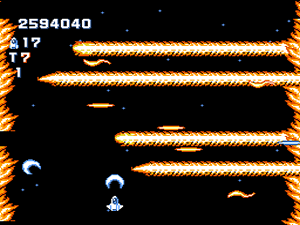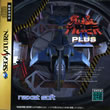Checkpoints OFF
1 Difficulty level
5 Stages
Ship speed selectable at start
- - - - - - -
Developed by Hyper-Devbox / Ziggurat Interactive
Published by Limited Run Games in 2022
Talk about unexpected resurgences, and ExZeus - The Complete Collection is certainly a release that *might* have drawn some attention when coming out for recent platforms a little while ago, both digitally and also in retail form for the Nintendo Switch and the Playstation 4. This collection includes ExZeus and ExZeus 2, two rail shooters with unique approaches to the mecha motif that always flew under the radar ever since gracing the arcades, and in the case of the first game gaining obscure ports such as those made for the Playstation 2 and the Nintendo Wii.
ExZeus won't set the world of any rail shooter fan on fire, but it at least has enough spectacle to get you through five stages of uneven intensity and fluctuating stakes. It all starts with the choice between three mechas with varying stats for power, speed and stamina, and then getting used to the slightly unorthodox gameplay, for rail shooters that is. At a distance ExZeus sounds like a Transformers game where you won't be able to transform at all, and up close it's a feast of in-your-face bullets, with lasers and melee attacks often killing you in the blink of an eye.
"Where did my energy meter suddenly go", you wonder? Well, you can either continue (with the unwanted benefit of not resetting your score) or start over if you're one of those players who aim for the 1CC no matter what.
Calista versus Dracaena
Button × is responsible for three inputs: fire, fire guided missiles on enemies targeted by the lock-on attack (button ○) and release the megalaser attack, a special laser burst that works with a meter that recharges over time automatically. Button □ drops the mega bomb over the screen, but you can only use it three times during the duration of any full credit. L1 and R1 provide a quick rolling maneuver left and right, but you can also double tap in order to achieve the same effect. Items appear floating in the air from destroyed enemies, and although most of them are random at least the POWER for shot upgrades seems to show up under the same circumstances at all times while you're in need of power-ups. Take one to get a 3-way spread, then another one to max out at a 5-way horizontal spread.
The remainder of the items can be lock-on energy (if you run out of it you can't use this resource), gold tokens, booster and either shield or energy refills. The shield is the first barrier against damage and is shown in the upper left part of the HUD. Once without the shield you start losing the energy of the robot, which appears on the left side of the screen and means game over if depleted. Booster just makes you fly faster, helping you out in the time bonus at the end of the level. Finally, gold tokens accumulate in a counter for you to use in between levels in order to extend your energy, shield or lock-on meters, as well as purchase refills. Since the gold counter maxes out at 999, there's no sense in saving gold whatsoever. Watch out for the shop screen though because it opens up right over the Exit button, so try to avoid getting trigger happy there.
Gameplay in ExZeus is rather obtuse, in a clunky and unexpected way. As with any other game that requires memorization it will demand knowledge of what's coming ahead, but given how the screen might move in relation to the character (in a wider scope than what you can immediately see) adaptation is extremely important to survive. Damage is directly related to the amount of bullets or lasers that hit you in a single blow, and it's not uncommon to go from a full energy meter to the brink of death if you happen to be mass targeted. Heavy damage also powers you down one level or even two levels, sending you back to the default shot right away. When in doubt about what's coming ahead it's just better to be safe than sorry, even though you might be tempted to stay in the line of fire to destroy an enemy since all on-screen bullets fired by your target will turn into gold if you're able to kill it.
Boss fights are in a category of their own. The main strategy with all of them is finding their rhythm and pounding their weak spots in between their attacks. The further you get the more aggressive they become, of course. Just note that whenever they're blue they're invincible to regular attacks, and the only way to hit them is by using lock-on shots. On the other hand, a fully powered megalaser also renders you invincible.
Release trailer for ExZeus - The Complete Collection for the Playstation 4
(courtesy of YouTube user and developer Ziggurat Interactive)
(courtesy of YouTube user and developer Ziggurat Interactive)
As a result, the Playstation 4 version is slightly harder with less opportunities for scoring. The scoring system preserves the elementary hit counter during levels but implements a series of end-of-stage bonuses based on your performance. Available options do not include any tweaks for extra difficulties or screen swing/shaking, only the possibility to invert the Y axis and to apply a normal/cool graphic mode switch that doesn't seem to do affect anything whatsoever.
And here's my final 1CC result for ExZeus on the Playstation 4. I played with robot Sophia (blue), the most balanced of the three, but my overall impression is that maneuveratibility is still more important than brute force. In that sense, Calista (red) might be a better choice.
Coming up next: ExZeus 2.































